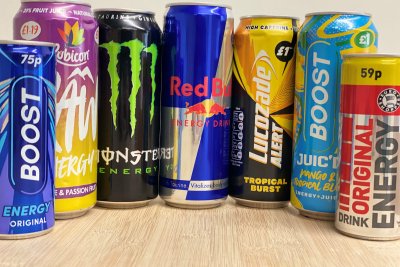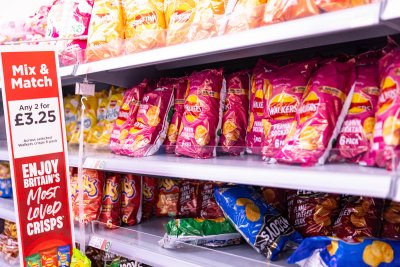TV advert analysis reveals true content of ad breaks
- new campaign launched to close junk food marketing loopholes
Millions of young people are being exposed to ads during primetime TV which are banned from children’s programming.
An analysis of over 750 adverts found almost one in four TV ads shown between eight and nine pm were for food (22%), with viewers seeing as many as six junk food adverts per hour.
Within these food ads, the most frequently shown were unhealthy products from supermarkets such as Aldi and Morrisons (25%), followed by fast-food chains such as KFC (13%), with chocolate and sweet companies like Lindt and Haribo the third most common (12%). (1)
Figures show that children’s TV viewing peaks around eight pm, but laws created to protect kids from targeted ads don’t typically cover this time. This oversight leaves a glaring loophole in junk food marketing, which urgently needs to be closed. (2)
An alliance of concerned organisations, Action on Junk Food Marketing, headed by the Children’s Food Campaign and the British Heart Foundation (BHF), have commissioned this research to spur the Government and Ofcom to take action to protect children.
The clips analysed seem designed for a young audience, with nearly a third (31%) of food adverts shown between eight and nine pm using themes of ‘fun’ rather than more adult concerns of price or convenience. What’s more, over half of these clips used children or child-aged characters to promote their food (53%).
With around a third of UK children now overweight or obese, Action on Junk Food Marketing has released these alarming findings to urge people to get behind a new petition calling on the Government to block junk food marketing to children. (3)
To shield younger audiences from persuasive promotion, campaigners want to see ads for unhealthy food pushed back until after the 9pm watershed. This should be combined with consistent regulation online to stop children being bombarded with internet advertising. (4)
An ad break only lasts three minutes, but product promotion lasts much longer. Around a third of ads studied ended with a website or Twitter hashtag - a key way of reaching teenagers, as thirty six per cent of 8-15 year olds use smartphones or laptops ‘most times’ when watching TV. (5)
Simon Gillespie, Chief Executive of the BHF, said:
“Parents don’t expect their children to be bombarded with ads for unhealthy food during primetime TV, but that’s exactly what happens.Even when the show is over, junk food marketers could be reaching out to young people online. A lack of regulation means companies are free to lure kids into playing games and entering competitions – all with a view to pushing their product.We want the Government to protect children by switching off junk food adverts on TV until after 9pm and putting rules in place to stop children becoming fair game for internet marketing.”
Lyn Rodney, whose diabetes diagnosis led to a healthier diet for her and her teenage son, said:
“As a busy mum, it’s hard enough to make sure your family eats healthily without seeing ads for junk food wherever you go.In the past, unhealthy food became a quick and easy option for me and my son. However, I now know that being overweight may have contributed to my diabetes and I want to do everything within my power to stop my son getting the same condition. It’s upsetting to see so many ads for junk food on TV and online. I’m getting behind this call to restrict junk food marketing for the sake of my son and the future health of kids his age.”
To sign the petition and protect young people from junk food marketing, visit bhf.org.uk/ditchthejunk
Notes to editors
1. Rosa Whalen and Emma Boyland, Department of Psychological Sciences, University of Liverpool. Analysis conducted from 25.10.13 to 13.12.13, including 20.75 hours of TV and 784 adverts. Channels analysed were ITV and Channel 4. Programmes included were X Factor, The Simpsons and Hollyoaks. Brands featured in the sample include: KFC, Aldi, Morrisons, Lindt, Haribo, Coca-Cola and Cadbury’s amongst others. Download a copy of the full research.
2. Ofcom (May 2013) ‘Children and young people’s exposure to alcohol advertising.’ Section 1.3.
3. ‘Coronary heart disease statistics’, 2012 edition. British Heart Foundation Health Promotion Research Group, Department of Public Health, University of England.
4. Children’s Food Campaign (2013) ‘Through the Looking Glass: A review of topsy-turvy junk food marketing regulations’. Available: www.sustainweb.org/publications/?id=273
5. Ofcom (2013)
Action on Junk Food Marketing members include: the British Heart Foundation, the Children’s Food Campaign, the Faculty of Public Health, the department of Psychological Sciences at the University of Liverpool, the Royal College of Paediatrics and Child Health, the British Dental Association, the Academy of Medical Royal Colleges, the Health Equalities Group, Heart of Mersey, the Family and Childcare Trust, the UK Health Forum, the Association for the Study of Obesity.
Briefing:
Action on Junk Food Marketing has produced a briefing on junk food marketing to children on TV and online. Download a copy of the briefing.
Additional information:
We are aware that the Committee of Advertising Practice (CAP) and the Advertising Standards Authority (ASA) are in the process of undertaking a comprehensive literature review of evidence relating to the impact of digital and online marketing of food and drink products to children.
However, we are sceptical about the need for another evidence review and are greatly concerned that a commercial organisation rather than an independent academic institution or a recognised academic in this field has been commissioned to undertake this review. We have fed into the review and hope that the full findings will be available to view in the public domain. We know the evidence will speak for itself, and point to the need for stronger regulation.
Children's Food Campaign: Campaigning for policy changes so that all children can easily eat sustainable and healthy food.










